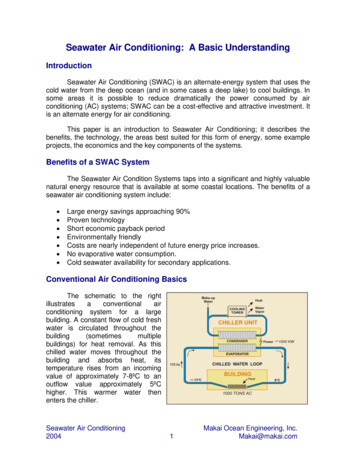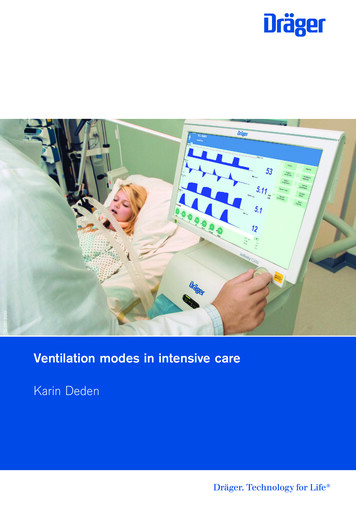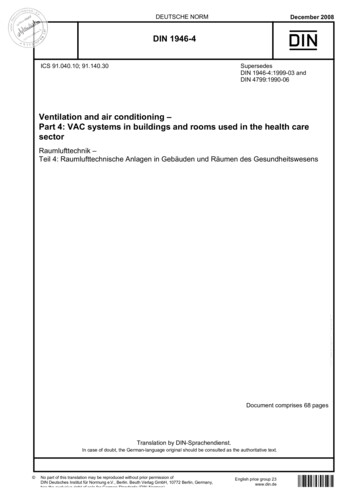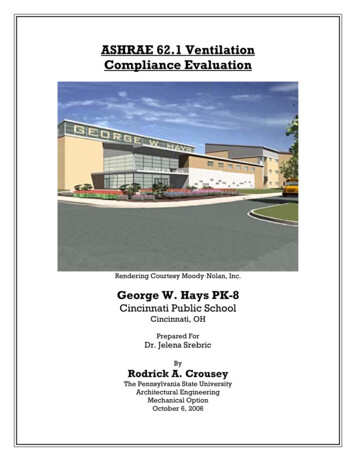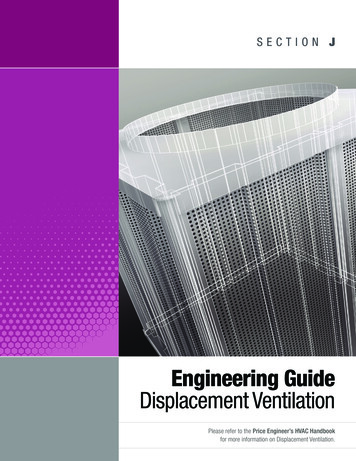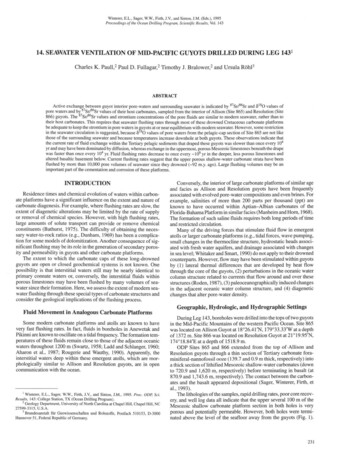
Transcription
Winterer, E.L., Sager, W.W., Firth, J.V., and Sinton, J.M. (Eds.), 1995Proceedings of the Ocean Drilling Program, Scientific Results, Vol. 14314. SEAWATER VENTILATION OF MID-PACIFIC GUYOTS DRILLED DURING LEG 1431Charles K. Paull,2 Paul D. Fullagar,2 Timothy J. Bralower,2 and Ursula Röhl3ABSTRACT18Active exchange between guyot interior pore-waters and surrounding seawater is indicated by 87Sr/86Sr and δ θ values of8786pore waters and by Sr/ Sr values of their host carbonates, sampled from the interior of Allison (Site 865) and Resolution (Site8786866) guyots. The Sr/ Sr values and strontium concentrations of the pore fluids are similar to modern seawater, rather than totheir host carbonates. This requires that seawater flushing rates through most of these drowned Cretaceous carbonate platformsbe adequate to keep the strontium in pore waters in guyots at or near equilibrium with modern seawater. However, some restrictionin the seawater circulation is suggested, because δ O values of pore waters from the pelagic-cap section of Site 865 are not likethose of the surrounding seawater and because temperatures increase downhole at both guyots. These observations indicate that4the current rate of fluid exchange within the Tertiary pelagic sediments that draped these guyots was slower than once every I0yr and may have been dominated by diffusion, whereas exchange in the uppermost, porous Mesozoic limestones beneath the drapewas faster than once every I0 4 yr. Fluid flushing rates decrease to once every 106 yr in the deeper, less porous limestones andaltered basaltic basement below. Current flushing rates suggest that the upper porous shallow-water carbonate strata have beenflushed by more than 10,000 pore volumes of seawater since they drowned (-92 m.y. ago). Large flushing volumes may be animportant part of the cementation and corrosion of these platforms.INTRODUCTIONResidence times and chemical evolution of waters within carbonate platforms have a significant influence on the extent and nature ofcarbonate diagenesis. For example, where flushing rates are slow, theextent of diagenetic alterations may be limited by the rate of supplyor removal of chemical species. However, with high flushing rates,large amounts of solute transport can provide or remove chemicalconstituents (Bathurst, 1975). The difficulty of obtaining the necessary water-to-rock ratios (e.g., Dunham, 1969) has been a complication for some models of dolomitization. Another consequence of significant flushing may be its role in the generation of secondary porosity and permeability in guyots and other carbonate platforms.The extent to which the carbonate caps of these long-drownedguyots are open or closed geochemical systems is not known. Onepossibility is that interstitial waters still may be nearly identical toprimary connate waters or, conversely, the interstitial fluids withinporous limestones may have been flushed by many volumes of seawater since their formation. Here, we assess the extent of modern seawater flushing through these special types of carbonate structures andconsider the geological implications of the flushing process.Fluid Movement in Analogous Carbonate PlatformsSome modern carbonate platforms and atolls are known to havevery fast flushing rates. In fact, fluids in boreholes in Anewetak andPikinni are known to oscillate on a tidal frequency. The formation temperatures of these fluids remain close to those of the adjacent oceanicwaters throughout 1200 m (Swartz, 1958; Ladd and Schlanger, 1960;Aharon et al., 1987; Rougerie and Wauthy, 1990). Apparently, theinterstitial waters deep within these emergent atolls, which are morphologically similar to Allison and Resolution guyots, are in opencommunication with the ocean.Winterer, E.L., Sager, W.W., Firth, J.V., and Sinton, J.M., 1995. Proc. ODP, Sci.Results, 143: College Station, TX (Ocean Drilling Program).2Geology Department, University of North Carolina at Chapel Hill, Chapel Hill, NC27599-3315, U.S.A.3Brundesanstalt für Geowissenschaften und Rohstoffe, Postfach 510153, D-3000Hannover 51, Federal Republic of Germany.Conversely, the interior of large carbonate platforms of similar ageand facies as Allison and Resolution guyots have been frequentlyassociated with evolved pore-water compositions and even brines. Forexample, salinities of more than 200 parts per thousand (ppt) areknown to have occurred within Aptian-Albian carbonates of theFlorida-Bahama Platform in similar facies (Manheim and Horn, 1968).The formation of such saline fluids requires both long periods of timeand restricted circulation.Many of the driving forces that stimulate fluid flow in emergentatolls or larger carbonate platforms (e.g., tidal forces, wave pumping,small changes in the thermocline structure, hydrostatic heads associated with fresh water aquifers, and drainage associated with changesin sea level; Whitaker and Smart, 1990) do not apply to their drownedcounterparts. However, flow may have been stimulated within guyotsby (1) lateral thermal differences that are developed by heat flowthrough the core of the guyots, (2) perturbations in the oceanic watercolumn structure related to currents that flow around and over thesestructures (Roden, 1987), (3) paleoceanographically induced changesin the adjacent oceanic water column structure, and (4) diageneticchanges that alter pore-water density.Geographic, Hydrologic, and Hydrographic SettingsDuring Leg 143, boreholes were drilled into the tops of two guyotsin the Mid-Pacific Mountains of the western Pacific Ocean. Site 865was located on Allison Guyot at 18 26.41'N, 179 33.33'W at a depthof 1372 m. Site 866 was located on Resolution Guyot at 21 19.95'N,174 18.84'E at a depth of 1518.9 m.ODP Sites 865 and 866 extended from the top of Allison andResolution guyots through a thin section of Tertiary carbonate foraminiferal-nannofossil ooze (139.7 and 0.9 m thick, respectively) intoa thick section of lithified Mesozoic shallow-water carbonates (downto 720.9 and 1,620 m, respectively) before terminating in basalt (at870.9 and 1,743.6 m, respectively). The contact between the carbonates and the basalt appeared depositional (Sager, Winterer, Firth, etal., 1993).The lithologies of the samples, rapid drilling rates, poor core recovery, and well log data all indicate that the upper several 100 m of theMesozoic shallow carbonate platform section in both holes is veryporous and potentially permeable. However, both holes were terminated above the level of the seafloor away from the guyots (Fig. 1).231
C.K. PAULL, P.D. FULLAGAR, T.J. BRALOWER, U. ROHLI* 1 Basaltl&gg&l Pelagic oozeI I I Shallow-water limestoneIC? I Porous limestoneFigure 1. Schematic cross section showing the location of boreholes drilled atAllison (ODP Site 865) and Resolution (Site 866) guyots, with respect to anidealized guyot topography. The relationship to the pelagic carbonates (foraminiferal nannofossil oozes), shallow-water carbonates, and basaltic basement isindicated. The upper -600 m of the shallow-water carbonates are especiallyporous, as indicated with the cavernous porosity symbol. Note that the boreholesterminated at depths that were shallower than the seafloor surrounding thesecarbonate capped pedestals. Also indicated are potential pore-water flow lines.Thus, fluid movements within these guyots might easily have involvedexchange with the adjacent seawater through the flanks or exposedsummits of these porous shallow-water carbonate edifices.The hydrologic settings of Sites 865 and 866 differ in that Site 865was drilled about 5.7 km away from the edge of the platform, whileSite 866 was located only 2.4 km from its edge. In addition, the139.7-m-thick pelagic-cap at Site 865 may have acted as an impermeable confining layer overlying the relatively permeable shallow-waterlimestones below. However, the pelagic-cap at Site 866 was of nominalthickness ( l m)(Sager, Winterer, Firth, et al, 1993). The mid-Pacificwaters that surround these guyots are about 4 C at the tops of theseboreholes (Reed, 1969; Edmond et al., 1971) and decrease by morethan 2 C over the 1671 m that was logged at Site 866.water. At deposition, carbonates and the original pore-waters have thesame isotopic values as seawater (e.g., Burke et al., 1982; Hess et al.,1986; Ludwig et al., 1988). However, long-term modifications inglobal chemical budgets slowly change the strontium isotopic composition of the ocean (Brass, 1976). The general trends of seawater8786strontium isotopic composition ( Sr/ Sr) are well known backthrough the Cretaceous (Hess et al., 1986) with values of Early Cretaceous seawater (as monitored by the carbonates) of 0.707 and modernseawater values of 0.709. Thus, by measuring differences between8786the Sr/ Sr values in pore waters and their host carbonates of knownage, one can assess how much of the interstitial strontium is originaland how much has been transported into the system (e.g., Baker et al.,1991;Elderfieldetal., 1993).The guyots drilled during Leg 143 are particularly good places tostudy flushing histories using strontium isotopes as a circulationtracer because (1) most of these carbonate-rich rocks have extremelylow clay contents; thus, other sources of strontium that can make theinterpretation of strontium isotope data equivocal in other settings(Elderfield and Gieskes, 1982) are reduced or eliminated and (2) thestrontium isotopic compositions of the Lower Cretaceous carbonatesand modern seawater are distinct, and changes between these twotime periods have been essentially unidirectional.δ 1 8 θ Values as Tracers of Seawater vs. Connate Watersδ 1 8 θ values of oceanic waters are known to have changed withglobal ice volume (Shackleton and Opdyke, 1973; Schrag andDePaolo, 1993). Heavier values occurred during glacial periods andlighter values during interglacials. Because the Earth is now in aninterglacial period, the average value of modern seawater is nearly ata minimum for the Quaternary. Thus, δ 1 8 θ values of interstitial watersfrom within these guyots would be expected to differ from the seawater that surrounds them, unless the flushing was fast enough tohave completely replenished these structures over the last -10,000 yrsince the last ice age.METHODSAlteration History of the CarbonatesThe Mesozoic carbonates are well lithified and are composed oflow-Mg calcite and lesser amounts of dolomite in some of the deepercores. These lithologies indicate that a substantial amount of alteration occurred at some point in their history (Sager, Winterer, Firth, etal., 1993).The pelagic-cap samples from Site 865 are unlithified and exceptfor some dissolution have undergone little diagenetic alteration(Sager, Winterer, Firth, et al., 1993; Röhl et al., this volume).Shipboard Measurements and ObservationsRoutine shipboard pore-water composition measurements (i.e.,Cr, Sθ -, NH}, Ca2 , Mg2 , Sr2 ) for the Cretaceous guyots drilledduring Leg 143 show compositions that are mostly similar to seawater(Sager, Winterer, Firth, et al., 1993). However, the pore-waters fromthe Mesozoic shallow-water limestone contain less sulfate and someammonium, indicating that minor compositional evolution of thesampled waters associated with microbial processes occurred. Shipboard Sr2 data indicated that some samples had slightly lower Sr2 concentrations than modern seawater. Unfortunately, with the shipboard data alone, we cannot distinguish whether the interiors of theseguyots were relatively inert or were flushed rapidly with seawater.Strontium Isotopes as Tracersof Seawater vs. Connate WatersStrontium isotope stratigraphies are based on the observation thatthe ocean is well-mixed with respect to strontium and that carbonates,which form in ocean waters, reflect the isotopic composition of sea-Pore waters were isolated from unlithified pelagic-cap samples andfrom lithified limestone samples. Analyses were conducted on seawater, pore waters, and the carbonates in the solid phases of samplesfrom Sites 865 and 866.Pore Waters from Unlithified Samples87Sr/86Sr analyses were conducted on pore waters that had beensqueezed from the sediments that came from the pelagic caps of theseguyots: 15 samples from Allison (Site 865) and one sample fromResolution Guyot (Site 866) (Table 1). Whole-round sections of thesediments were cut from the cores shortly after recovery. These sediments were extruded from the core liners, and the exterior of thesediment section was cut away. Waters from this material were extracted with a hydraulic squeezer (Sager, Winterer, Firth, et al., 1993).87Sr/86Sr analyses were done on two water samples (from the pelagiccap of Allison Guyot), collected in situ with the water sampling temperature probe (WSTP) (Table 1). Fourteen pore-water samples fromthe pelagic cap of Allison Guyot (Hole 865B) having sufficient wateryields ( 20 mL) were also selected for δ 1 8 O H 0 analyses (Table 1).Pore Waters from Lithified Samples8786Sr/ Sr analyses were conducted on five pore-water samples fromAllison Guyot and 19 pore-water samples from Resolution Guyot thathad been squeezed directly from the platform limestones. None ofthese samples, however, came from the uppermost parts of the shallow-water limestones, where core recovery was lowest and whereporosities (and permeabilities?) are thought to have been highest.
SEAWATER VENTILATION OF MID-PACIFIC GUYOTSTable 1.87Sr/86Sr, δ 1 8 O H 2 θ and Sr concentration data in the unlithified Tertiary pelagic carbonates from Allison (Site 865) and Resolution (Site 866)guyots.δ18oCore, section,interval (cm)143-865B1H-6, 80-852H-5, 145-1503H-6, 145-1504H-5, 145-1505H-4, 145-1506H-5,145-1507H-1,0-10Λ7H-2, 145-1508H-5, 145-1509H-5, 145-15010H-4, 145-15012H-5, 145-15013H-5, 145-15014H-3, 145-15014H-5, 147-150lSX-l.O-lO*15X-1, 145-15015X-2, 145-150143-866A1R-2,47-48Depth(mbsf)87Sr/ 8 6 Sr 31.200.70884587Sr/ 8 6 Sr 6728.8621.0706.4Notes: Identification of samples include ODP borehole, core and section numbers, interval downsection in cm, and meters below seafloor (mbsf) to the top of the sampled interval.87Sr/ 8 6 Sr values of the pelagic carbonates analytical errors (one standard deviation internal precision),8 7 Sr/ 8 6 Sr values of the pore-waters analytical errors (one standard deviation internal precision), δ 1 8 O H 0 values, Sr concentrations in the carbonates, and Sr concentration in the pore waters also are given. Samples collected with the WSTP tool fromwithin the pelagic-cap are indicated with Λ . Pore-water sample vials 12H-5 and 15X-1 were observed to be cracked before analysis, thus some evaporation may have occurred,causing increases in Sr concentration.Surfaces of these Cretaceous shallow-water carbonate samples weretoo firm to cut away the exterior parts of the samples, which potentially are contaminated with seawater. To remove surface waters, therocks were wiped with a paper towel. These cleaned rock samples wereplaced into a sturdy plastic bag and struck with a hammer until therocks broke into less than cubic-centimeter-sized pieces. Pieces of rockthen were picked up with tweezers and placed into the squeezing pistons. Hydraulic squeezing of about 30 g of these small pieces yieldedfrom 1.5 to 5.5 mL of water. All pore-water samples for isotopic analysis were sealed in glass ampules for shipment to the laboratory.Solid-phase Samples8786Sr/ Sr analyses were conducted on the carbonate that remainedin the hydraulic squeezers (called squeeze cakes) from which porewaters were extracted. Additional solid-phase 87Sr/86Sr analyses wereconducted on rock chips.87Sr/ 86 Sr and δ 1 8 θ Analytic ProceduresSolid samples were removed from the sealed plastic bags in whichthey were stored, shaved with a razor blade to remove the exterior ofthe sample before about 5 to 10 mg of clean shavings were placed intoa 7-mL Savillex teflon vial. Pore-water samples were decanted fromthe sealed glass vials in which they were stored aboard the ship intoteflon vials.After weighing, a 84 Sr spike was added to all samples. One milliliterof 1 normal acetic acid prepared from Ultrex ultra-pure acetic acid wasadded, and the carbonate samples were placed on a hot plate for 1 hr orless. The strontium-bearing liquid was removed with a pipette toseparate any remaining insoluble materials before being evaporated todryness. The samples were then re-acidified with dilute nitric acid. Astrontium concentrate was obtained from these liquid samples by ionchromatographic techniques using a crown ether cation exchange resin(Sr Spec). Measurements were performed with a VG Sector 54 massspectrometer in the Geology Department at the University of NorthCarolina at Chapel Hill. Values have been normalized to 86/88 0.1194 using exponential normalization. During this study, we analyzed 104 splits of National Bureau of Standards strontium isotopicstandard SRM-987. The average 87Sr/86Sr value was 0.710250 0.000011 (one standard deviation). The results for three to six (generally five) SRM-987 standards run in the same turret with unknownswere used to adjust the 87Sr/86Sr values for unknowns (i.e., 0.710250was accepted as the correct value, and if the 87Sr/86Sr ratio for standards averaged 0.710245, then 0.000005 was added to the 87Sr/86Srratio for each sample in the turret).Sr concentrations were obtained using standard mass spectrometric isotope dilution techniques using 84 Sr spike. Replicate analyses ofstandard samples indicate that Sr measurements have accuracy andprecision of better than 1 % of the measured concentration.Oxygen isotopic compositions of pore-waters were measured atGlobal Geochemistry. Samples for δ 1 8 O H o measurement were prepared by equilibration with CO 2 (Epstein and Mayeda, 1953; Wongand Klein, 1986) and were reported with an accuracy of 0.1%o.Borehole temperature measurements were made in Holes 865Aand 866A during logging runs. Temperature measurements were performed as the logging tool entered the hole (Sager, Winterer, Firth, etal., 1993).RESULTSStrontium Isotopes: Seawater87The mean Sr/86Sr value of five measurements of modern seawater is 0.709167 0.000012 (Table 2) and agrees well with previouslyreported values for modern seawater (Table 3).Strontium Isotopes: Pelagic SedimentsThe uppermost pelagic carbonate sample from Allison Guyot, Site865A (interval 143-865A-1H-6, 80-85 cm), at a depth of 8.30 m hasa 87Sr/86Sr value of 0.708770 (Fig. 2A). This sample is Miocene in age(Sager, Winterer, Firth, et al., 1993). 87Sr/86Sr values were measuredin one sample (143-865 A- 1R-02,47-48) from 1.20 m into the pelagiccap of Resolution Guyot (Hole 866B). This pelagic carbonate samplewas assigned a late Pliocene age on the basis of its fossil content (adiverse Neogene assemblage that indicated reworking) and has a87Sr/86Sr value of 0.708845, while its pore water has a value of0.709163 (Fig. 2B). All the remaining 15 carbonate samples from thei
C.K. PAULL, P.D. FULLAGAR, T.J. BRALOWER, U. ROHL87Sr/86Sr0.70750.7065o Carbonates0.708587 Sr/ 86 SrB0.70750.7065o4- Carbonates0.70950.70850.7095 f O Pore-waterO Pore-waterßCOf Sα QCfl*QAllison Guyotooo oooooResolution GuyotFigure 2.8 7 Sr 8 6 Sr values that were measured in the carbonates (pluses) and their waters (circles) in Sites 865 (A) and 866 (B) vs. depth in the hole are shown. Theidealized stratigraphic columns indicate the contacts between the pelagic and shallow-water carbonates and the contact between the shallow-water carbonates andbasalt. Note that no samples were analyzed from the upper section of the shallow-water limestone units at Site 866, which are suspected of being very porous(indicated by schematic voids in the stratigraphic column). Dashed line indicates the modern 87 Sr/ 86 Sr value of seawater.pelagic cap at Site 865 are Paleogene in age and vary in87Sr/86Srvalues from 0.707723 to 0.707858 (Fig. 2A). The pore waters in all16 pelagic carbonate samples and from two samples collected in situwith the WSTP from Site 865 vary from 0.709006 to 0.709230, witha mean value of 0.709213 0.000057.Strontium Isotopes: Shallow-water Carbonate SedimentsThe values of all 56 shallow-water carbonate samples that weremeasured from Hole 865 A vary from 0.706991 to 0.707644 (Fig. 2A).The 87Sr/86Sr values of 19 shallow-water carbonate samples from Hole866A vary from 0.707291 to 0.707617 (Fig. 2B). Most of the slightlylarger variation in Site 865 samples relative to Site 866 samples comesfrom the lowest four samples, in which the CaCO3 percentages decrease to 82% to 94%.The five pore-water samples available for87Sr/86Sr analysis fromwithin the shallow-water carbonates of Hole 865A show a considerable trend toward lower 87Sr/86Sr values downcore (from 0.708698 at679.70 m to 0.707090 at 816.82 m; Fig. 2A). The deepest two porewater samples have 87Sr/86Sr values of less than their host carbonates.The available pore-water samples (22 measurements on 18 samples)for 87Sr/86Sr analysis from within the shallow-water carbonates ofHole 866A vary from 0.708722 to 0.709109 (Fig. 2B).Strontium Concentrations: Pore-watersThe Sr concentrations that were measured by isotope dilution on all51 pore-water samples only ranged from 4.2 to 14.2 ppm, with a meanvalue of 7.5 1.5 ppm. The range of measured Sr concentration in thesamples with uncracked vials from the pelagic cap was even smaller:7.4 to 8.2 ppm, with a mean of 7.6 0.2 ppm. The values of the fivesamples of surface seawater ranged from 7.1 to 7.3 ppm with a meanvalue of 7.22 0.08 ppm. Some of the slight difference between thesurface and pore waters can be explained by the relatively low salinitiesof the North Pacific surface waters.The pore-water Sr concentrations in 27 samples from the shallowwater carbonates range from 4.2 to 14.2 ppm and have a mean value of7.3 2.0 ppm. The samples having the highest Sr concentrations (13.2and 14.2 ppm) came from the base of Hole 865A, near the basalticbasement. Excluding these samples, the remaining 25 samples havepore-water values that range between 4.2 and 8.3 ppm, with a meanvalue of 6.8 0.8 ppm. While the scatter in these samples is greaterthan in the pelagic-cap samples, they (as a group) also are indistinguishable from seawater.The Sr concentrations that were measured on shipboard were similar to the more precise isotopic dilution values of this study. Specifically, shipboard analyses report a general decrease of Sr concentrationsbelow seawater values with increasing depth in Hole 866A and a Srconcentration of about 4 ppm for Section 143-866A-162R-1 (same asthe isotope dilution value).Strontium Concentrations: CarbonatesCarbonate from the pelagic-cap samples of both Holes 865 A and866B had strontium concentrations that ranged from 406.5 to 958 ppmwith a mean value of 656 145 ppm in 18). The Sr concentrationsfor the stratigraphically deeper shallow-water carbonates ranged from92 to 631 ppm with a mean value of 212 90 ppm (n 73).Pore-water δ 1 8 θπ 2 o Valuesδ 1 8 O H o values from the pore waters in the pelagic cap of AllisonGuyot (Hole 865B) vary from -0.3 to 0.8‰ and have a mean value of0.24 0.32%o SMOW. The δ 1 8 θ value of modern Pacific Ocean deep
SEAWATER VENTILATION OF MID-PACIFIC GUYOTSTable 2. 87 Sr/ 86 Sr values and Sr concentration data in the lithified Mesozoic shallow-water carbonates from and Allison (Site 865) and Resolution (Site 866) guyots.Core, section,interval (cm)Depth(mbsf)87143-865A18R-CC, 12-14*19R-CC,0-l*21R-CC, 2-3*22R-CC, 12-13*23R-CC, 5-6*24R-CC, 3 *25R-CC, 1-2*26R-CC,0-l*27R-CC,0-l*28R-CC, 12-14*29R-CC, 3 *30R-CC, 2-3*32R-CC, 14-16*33R-CC, 2-3*34R-01, 130-132*35R-CC, 0-2*36R-CC, 21-22*37R-CC, 6-8*38R-CC,9-11*39R-CC, 4 2 3 *40R-CC, 35-36*41R-CC, 8-9*42R-CC, 14-16*44R-CC, 11-12*44R-CC, 11-12*45R-CC, 15-17*46R-CC, 3-5*48R-CC, 1-3*50R-CC, 1-3*51R-CC,7-9*52R-CC, 13-15*54R-CC, 1-3*55R-CC, 7-8*56R-CC, 4 1 2 *57R-CC, 12-13*58R-CC, 25-27*59R-CC, 8-10*60R-CC, 2-4*64R-CC, 17-20*65R-CC, 3 *66R-CC, 18-19*71R-CC.6-7*72R-CC, 6-7*73R-1, 18-20*73R-1, 73-7574R-1, 0-574R-1, 13-14*76R-1, 40-41*76R-1, 70-7578R-1, 70-7587R-3, 51-5487R-3, 51-5488R-2, 27-321R-4, 6A53R-1,41-4270R-2, 76-8071R-1, 12-1473R-1, 13-1676R-1, 53-5678R-2, 105-11184R-1,42 586R-1, 86-8991R-1, 104-10797R-1, 33-36t97R-1, 33-3697R-1, 33-3698R-1, 11-16102R-1, 16-20116R-l,22-27t116R-1,22-27120R-1, 34-38t120R-1, 34-38143R-1,90-93143R-l,90-93t156R-3, 70-74162R-1, 15-19SW-1SW-2SW-3SW-4SW-5Sr/ f ;6Sr 4640.7075470.0000050.000004—87Sr/86Sr errorpore .06.57.17.17.46.87.85.76.24.27.2Notes: Identification of samples include ODP borehole, core and section numbers, interval down section in cm, and depth below seafloor in meters to the top of the sampled interval.CC indicates core-catcher samples. 87Sr/86 Sr values of the carbonates analytical errors (one standard deviation internal precision), 87Sr/86 Sr values of the pore-waters analytical errors (one standard deviation internal precision), Sr concentrations in the carbonates, and Sr concentration in the pore waters are also given. Carbonate 8 'Sr/86 Sr values weremeasured on squeeze cake samples, unless marked by * to indicate that the sample was a rock chip, t indicates sample splits that were dipped into distilled water before beingwiped with paper towels.235
C.K. PAULL, P.D. FULLAGAR, T.J. BRALOWER, U. ROHL87868Table 3. Modern seawater Sr/ Sr values that have been reported inthe -0.20.018θ H200.20.40.60.81.0ReferenceNelson et al., 1991Nelson et al., 1991Burke et al, 1982Elderfield, 1986Hess et al., 1986UNC: Coleman, pers. comm., 1991UNC: Coleman, pers. comm.,1991bDePaolo and Ingram,1985bBurke et al., 1982 bHodelletal., 1989Palmer and Elderfield, 1985"fε1001Normalized to SRM-987 0.710250.' Indicates modern seawater values that have been inferred from measurement on modern shell material.waters are -0.17‰ SMOW (Craig and Gordon, 1965). Core samplesfrom the pelagic cap at Holes 865A, 865B, and 865C lack internalcohesion and experienced liquefaction during the splitting process18(Sager, Winterer, Firth, et al., 1993). The δ θ value of a sample ofsurface seawater was measured as 0.2‰ SMOW.The distribution of pore-water δ 1 8 θ values shows a consistentpattern (Fig. 3). Samples from 129.95 to 134.95 m near the base ofthe pelagic cap have values similar t
Active exchange between guyot interior pore-waters and surrounding seawater is indicated by 87Sr/86Sr and δ18θ values of pore waters and by 87Sr/86Sr values of their host carbonates, sampled from the interior of Allison (Site 865) and Resolution (Site . Whitaker and Smart, 1990) do not apply to their drowned counterparts. However, flow may .


